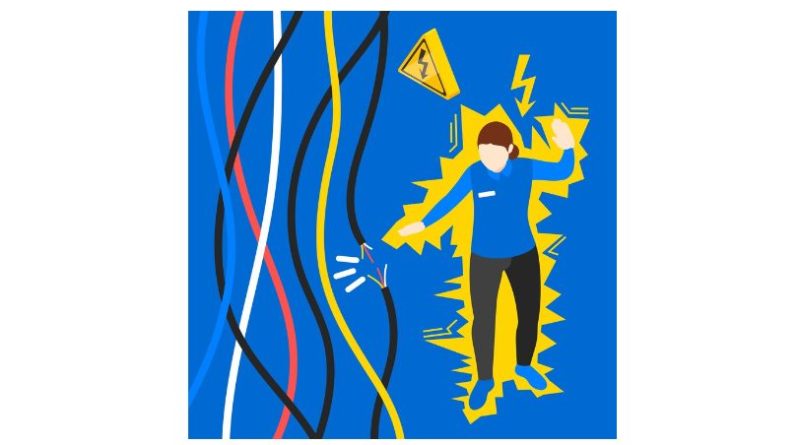Which is more dangerous: 1 Volt and 230 Amps of current or 230 Volts and 1 Amp of current?
Which is more dangerous: 1 Volt and 230 Amps of current or 230 Volts and 1 Amp of current?
Introduction
Electricity is a powerful force that surrounds us daily, but its behavior can be puzzling. The answer isn’t as straightforward as it might seem when determining which scenario is more dangerous – 1 Volt with 230 Amps or 230 Volts with 1 Amp. In this article, we’ll delve into the complexities of electrical voltage and current, exploring the factors that dictate danger levels and how to stay safe when dealing with electricity.
Both voltage and current pose potential hazards and risks when dealing with electricity. But which scenario is more dangerous – low voltage with high current or high voltage with low current? As we’ll discuss, the danger stems primarily from the current flowing through your body. A current of just 1 amp can be lethal. So, in this comparison, 1 volt and 230 amps of current present a much more significant hazard and higher fatality risk. Understanding the relationship between voltage, current, and electrical safety is crucial.

The Power of Voltage
Voltage, measured in volts (V), is the force that pushes electrons through a conductor. It’s what makes electrical devices function. Higher voltage means greater potential for electrons to flow, which can have significant safety implications.
The Significance of Current
Current, measured in amperes (A or amps), represents the flow rate of electrons in a circuit. Current is what causes electrical devices to operate. Higher current levels indicate more electrons flowing per unit of time.
Comparing 1 Volt & 230 Amps to 230 Volts & 1 Amp
To determine which scenario is more dangerous, we need to consider the power equation: Power (Watts) = Voltage (Volts) x Current (Amperes). Both scenarios result in the same power output (230 Watts). However, the danger isn’t solely dependent on power.
Electrical Resistance
Resistance, measured in ohms (Ω), is crucial to safety. It opposes the flow of current. Human skin, for example, offers resistance to electrical current. Higher resistance can protect against electrical shock.
Effects on the Human Body
The human body conducts electricity to some extent. Exposure to electrical current can cause various physiological responses, including muscle contractions, burns, and even cardiac arrest. The path the current takes through the body also matters.
Understanding electricity hazards
First, let’s discuss where electrical risks originate:
It’s the current that injures
Current flowing through the body disrupts nerve signals and muscle control, leading to shocks, burns, and cardiac arrest. Higher currents do more damage.
Voltage enables current flow.
Voltage creates an electric field that pushes current through resistance. Without sufficient voltage, current can’t overcome the body’s natural resistance.
Evaluating the scenarios
Looking at the two scenarios:
1V and 230A
1 volt is below the threshold needed to push significant current through the body’s resistance. But 230 amps is well above the few milliamps required to cause fatal cardiac fibrillation.
230V and 1A
While 230 volts is enough to drive current through the body, 1 amp by itself may or may not be immediately fatal, depending on duration.
Comparing severity
Overall, the massive current in the 1V, 230A scenario is more dangerous and likely to cause death.
Factors affecting shock intensity
The exact effects depend on additional factors:
Duration of contact
Longer contact allows more current to flow, doing more harm. Quickly jerking away can reduce injury.
Pathway through body
The current crossing the heart has the greatest risk of causing ventricular fibrillation. Other paths may cause burns.
Environmental conditions
Sweaty skin or wet conditions lower body resistance, allowing more current flow with the same voltage.
Safety precautions
Precautions to reduce electrical risks:
Insulation and enclosures
Cover live wires and parts to prevent accidental contact and current flows.
Warning signs
Post clear warnings to prevent access to hazardous energized equipment.
Protective gear
Wear insulated gloves, mats, and tools to work safely on live circuits.
Conclusion
In the end, while voltage and current can be dangerous, current is the primary factor that directly causes harm. A scenario with only 1 volt but over 200 amps of current is exponentially more hazardous than one with 230 volts and just 1 amp. Understanding this relationship allows proper safety precautions when working with electricity.
Determining which scenario is more dangerous – 1 Volt with 230 Amps or 230 Volts with 1 Amp – involves considering various factors. While both situations can be hazardous, higher voltage levels pose a greater risk, particularly when overcoming the body’s natural resistance.
FAQs
How much current is required to electrocute someone?
Just 20-100 milliamps (0.02-0.1 amps) of current flowing through the chest muscles can cause life-threatening cardiac fibrillation and respiratory paralysis.
What effect does the duration of an electric shock have?
Longer duration allows more current to flow through the body, increasing damage. A quick transient shock may cause a burn, while a sustained shock can be fatal.
Which is a bigger hazard – low voltage and high current or the reverse?
Low voltage and high current are more dangerous for a given power level since the current causes actual tissue damage. High voltage with low current tends to cause painful shocks.
How do electrical workers safely handle high voltage?
Through proper insulation, protective equipment like rubber gloves, and strict safety procedures. Special training is required to work on energized high-voltage equipment.
Can you get electrocuted by static electricity?
Static shocks are unpleasant but generally harmless because of the high voltage but minuscule current. The tiny charge dissipates almost instantly.
What are good insulators to handle live wires safely?
Dry rubber gloves and mats, fiberglass extension tools, and specially insulated gripping tools can insulate against high-voltage contact.
How does moisture impact electrical safety?
Water lowers skin resistance, allowing more current to flow through the body with a given voltage. Even small voltages can be dangerous in wet conditions.
Where is electrical current most dangerous when passing through the body?
Crossing the heart can induce ventricular fibrillation, the leading cause of death from electric shock. Thermal burns typically occur at points of contact.
What safety devices protect against electrical hazards?
Common safety devices include circuit breakers, fuses, ground fault and arc fault interrupters, insulation, warning signs and labels, and redundant safety cutoffs.
How can you tell if an electrical system is isolated and de-energized?
Follow lockout/tagout procedures to isolate all power sources. Then, confirm de-energization locally and remotely with the absence of voltage indications.
MCQs
Q1: Can I touch a live wire with a voltage of 1 Volt and 230 Amps?
A1: While 1 Volt and 230 Amps may not sound particularly dangerous, the danger of electrical shock isn’t solely determined by voltage or current alone. It also depends on factors like resistance, the pathway of the current, and the duration of contact. Generally, it’s crucial to avoid touching live wires regardless of voltage or current levels. Always assume a live wire is dangerous and take appropriate precautions.
Q2: Why do electricians wear rubber gloves and boots?
A2: Electricians wear rubber gloves and boots to insulate themselves from electrical currents. Rubber is an excellent insulator; this protective gear prevents direct contact between the electrician’s body and live electrical components. This reduces the risk of electric shock and ensures their safety when working on electrical systems.
Q3: Are there safe voltage levels for electrical work?
A3: There are no ultimately “safe” voltage levels when working with electricity. Electrical work should always be cautiously and safely approached, regardless of voltage levels. Low voltage can be hazardous under specific conditions, such as wet environments or faulty wiring.
Q4: How can I protect myself from electrical shock in my home?
A4: To protect yourself from electrical shock at home, follow these safety tips:
- Ensure that electrical outlets and wiring are in good condition.
- Use ground fault circuit interrupters (GFCIs) in areas with water sources.
- Avoid overloading electrical circuits.
- Use electrical appliances and tools that are in good working order.
- Keep electrical cords away from water.
- Never attempt DIY electrical work unless you are qualified.
Q5: Is it safe to use electrical appliances near water sources?
A5: Using electrical appliances near water sources can be dangerous. Water is a conductor of electricity, and mixing electricity with water can lead to electrical shock or even electrocution. It’s crucial to keep electrical appliances away from water and use GFCIs in areas where water is present, like bathrooms and kitchens, to enhance safety.
Q6: What should I do if someone gets electrocuted?
A6: If someone gets electrocuted, it’s essential to act quickly:
- Ensure your safety by turning off the power source if possible.
- Call 911 or emergency services immediately.
- Do not touch the person until you are sure the power is off.
- If necessary, perform CPR if the person is not breathing and has no pulse, but only if you are trained to do so.
- Wait for medical professionals to arrive for further treatment.
Q7: Can a low-voltage shock be harmful in any way?
A7: Yes, even a low-voltage shock can be harmful under certain conditions. Factors like the pathway of the current, the duration of contact, and the individual’s health can affect the outcome. It’s always best to avoid electrical shocks, regardless of voltage, as they can lead to injuries and health complications.
Q8: Are circuit breakers and GFCIs the same thing?
A8: Circuit breakers and ground fault circuit interrupters (GFCIs) serve different purposes. Circuit breakers protect electrical circuits from overloading and overheating, while GFCIs are designed to protect against ground faults, such as electrical leakage due to contact with water. Both are essential for electrical safety and serve different functions in preventing electrical hazards.
Q9: How can I test if an electrical circuit is safe?
A9: To test if an electrical circuit is safe, use a non-contact voltage tester or a multimeter to check for the presence of voltage. However, it’s crucial to exercise caution and ensure you have the necessary skills and knowledge to perform these tests safely. If you are uncertain, it’s best to consult a qualified electrician.
Q10: What are the most common causes of electrical accidents at home?
A10: The most common causes of electrical accidents at home include faulty wiring, overloading circuits, damaged electrical cords, water exposure near electrical outlets, DIY electrical work without proper knowledge, and misuse of electrical appliances. Ensure your electrical system is well-maintained and follows safety guidelines to prevent accidents.




